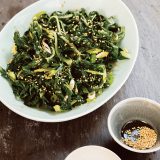Greens are a particular problem. Beyond salad, most of us are at a loss for easy ways to amplify flavor. It doesn’t help that most greens beyond lettuces—we’re talking the kales, chards and dandelion greens of the world—are naturally tough and bitter. Taming, tenderizing and flavoring them in one act is no small feat.
Yet Fuchsia Dunlop, a cookbook author and Chinese food expert, offered us a solution that is brilliant in its simplicity—sizzling oil.
Her recipe for sizzling greens borrows a classic Cantonese technique that does little more than pour hot oil over lightly blanched choy sum, a relative of bok choy, napa cabbage and mustard greens. When the oil hits, the greens sizzle, tenderizing just a bit, while the aromas of the scallions and fresh ginger scattered over the greens pop. It’s a powerful technique to transform flavors.
“You get a really vigorous sizzling sound, fizzing and sizzling, and that tells you that the oil is hot enough to awaken the amazing fragrances of the aromatics, and then you finish with soy sauce,” Dunlop explained
Sizzling oil is an easy way to enhance aromatics and fresh seasonings, such as scallions and grated fresh ginger. The hot oil draws out their flavors and aromas but still leaves them tasting fresh. Pile the ginger and aromatics over your dish, drizzle with hot oil, then toss. Finish with soy sauce and unseasoned rice vinegar. This works for all manner of vegetables, from broccoli and cauliflower to tender green beans, shredded carrots and julienned sugar snap peas. Hardier vegetables should be blanched in salted water until just tender, then drained. The technique also works on protein, such as poached fish or shrimp, chicken or tofu.
Using hot oil to dress greens, raw or blanched, isn’t unique to China. In Appalachia, the recipe for “killed lettuce” calls for hot bacon fat poured over greens. In France, an Alsatian cabbage salad calls for a mixture of hot bacon fat and olive oil. And in Japan, greens are plated, then topped with hot sesame oil, nori seaweed and sesame seeds.
But the most unusual example is Chinese splash-fried bean sprouts. This involves ladling hot oil over fresh sprouts topped with garlic and scallions, a process that cooks the sprouts and blooms the aromatics.
We loved the technique, but most of us don’t have choy sum on our grocery list. We wanted to adapt it to the more common Swiss chard. We found early on that while the leafy parts worked with this technique, the tough chard stalks didn’t. After a couple attempts, we decided they were best removed and saved for soups, stews or stir-fries.
We tried blanching the chard leaves in salted water, similar to Dunlop’s recipe, but no amount of squeezing and drying eliminated the excess water that the process added. Instead, we found that a brief saute and steam in a skillet was best for wilting the greens. It also was faster.
Any number of oils worked well, though olive oil was our least favorite.
Any number of oils worked well, though olive oil was our least favorite. Neutral oils, such as vegetable, grapeseed or rice bran were best. After several tests, we found we liked a blend of neutral oil and toasted sesame oil, the latter lending a savory touch. It took just a couple minutes over medium-high heat to get the oils hot enough to sizzle the greens and bloom the flavorings—fresh ginger, scallions and serrano chilies—we layered over them.
Traditional recipes call for the ginger to be julienned, but we found this left unpleasant fibrous chunks in the dish. We preferred to finely grate the ginger, and the best tool was a wand-style grater. This also was faster, easier and it released more of the aromatics.
To finish the dish, soy sauce alone is fine, but better was a blend of soy sauce and unseasoned rice vinegar, which adds a gentle acidity and light sweetness. Toasted sesame seeds added a nice finish.




